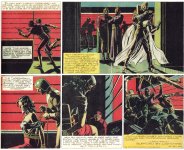Wifetheif
Experienced
- Joined
- Aug 18, 2012
- Posts
- 671
 It is nice to know that there are burlesque performers on Mongo! Seriously, this is Prince Barin's official royal welcome banquet? How much of that costume will she be left wearing after her routine ends? Imagine. THIS strip ran in millions of newspapers in the 1930s and nobody raised a stink. If this appeared in the Comics page today, the list of offended and outraged would be a mile long. This just shows what a talented artist or writer can accomplish when they couch their sensuality in a SF or fantasy context. Taking something off planet frees it from earth morals. So why not throw in an interplanetary strip show? To see a true master at work, check out Alexander Raymond's run of Flash Gordon. It is saturated with ideas straight out of a BDSM handbook with domination and submission clear and obvious subtexts. (To the astute reader.) What Game of Thrones does in chapters, Raymond accomplishes with a few brush strokes but the result is the same. SF and Fantasy are the artist's friend no matter their medium.
It is nice to know that there are burlesque performers on Mongo! Seriously, this is Prince Barin's official royal welcome banquet? How much of that costume will she be left wearing after her routine ends? Imagine. THIS strip ran in millions of newspapers in the 1930s and nobody raised a stink. If this appeared in the Comics page today, the list of offended and outraged would be a mile long. This just shows what a talented artist or writer can accomplish when they couch their sensuality in a SF or fantasy context. Taking something off planet frees it from earth morals. So why not throw in an interplanetary strip show? To see a true master at work, check out Alexander Raymond's run of Flash Gordon. It is saturated with ideas straight out of a BDSM handbook with domination and submission clear and obvious subtexts. (To the astute reader.) What Game of Thrones does in chapters, Raymond accomplishes with a few brush strokes but the result is the same. SF and Fantasy are the artist's friend no matter their medium.


